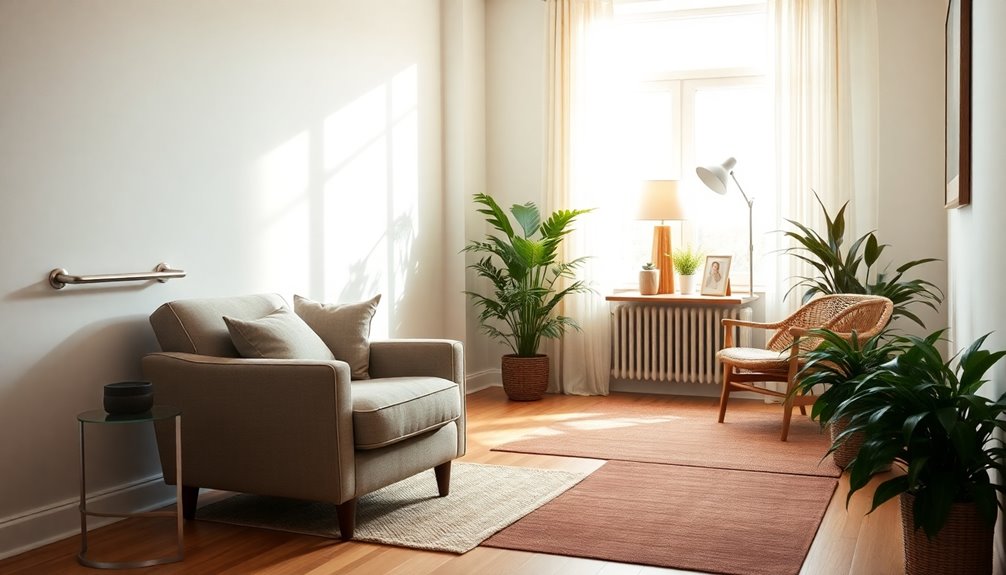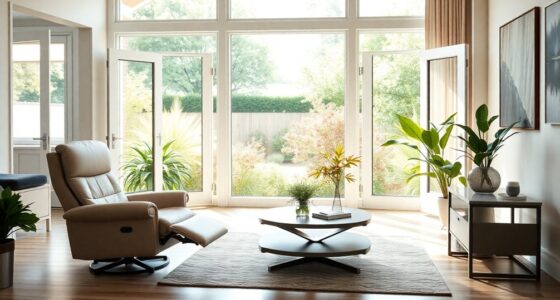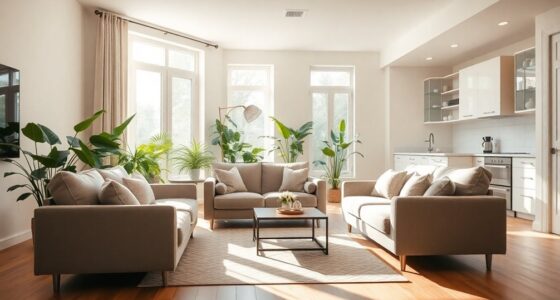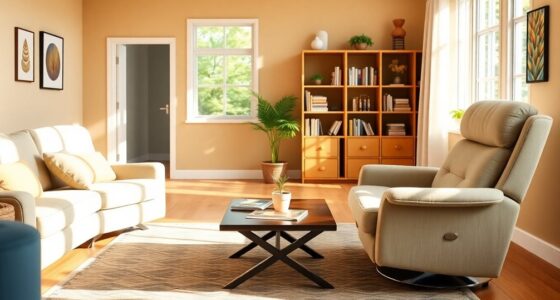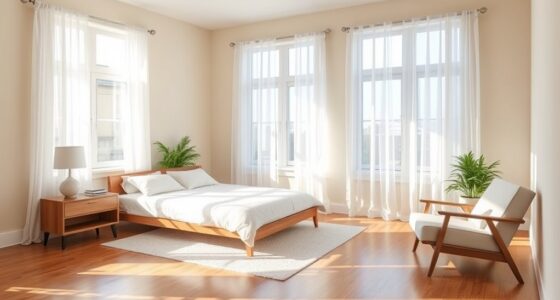Transform your home to boost safety and comfort for seniors with these essential upgrades. Start by improving lighting to enhance visibility, and install ramps and handrails for better mobility. Update flooring with slip-resistant options and consider modifications in the shower or bathtub for easier access. Widen doorways for wheelchair access and replace faucets to minimize contact. Finally, explore financial aid options to support your modifications. Stick around to discover more about each upgrade!
Key Takeaways
- Improve lighting with night lights and motion sensors to enhance visibility and reduce fall risks during nighttime navigation.
- Install ramps and handrails to provide vital support and safe access for seniors with mobility challenges.
- Upgrade flooring to slip-resistant options and install grab bars in bathrooms to minimize tripping hazards and enhance safety.
- Opt for touchless and anti-scald faucets to improve usability and prevent burns from hot water.
- Widen doorways to at least 32 inches to ensure accessibility for wheelchairs and walkers, promoting safer transitions between rooms.
Improve Lighting
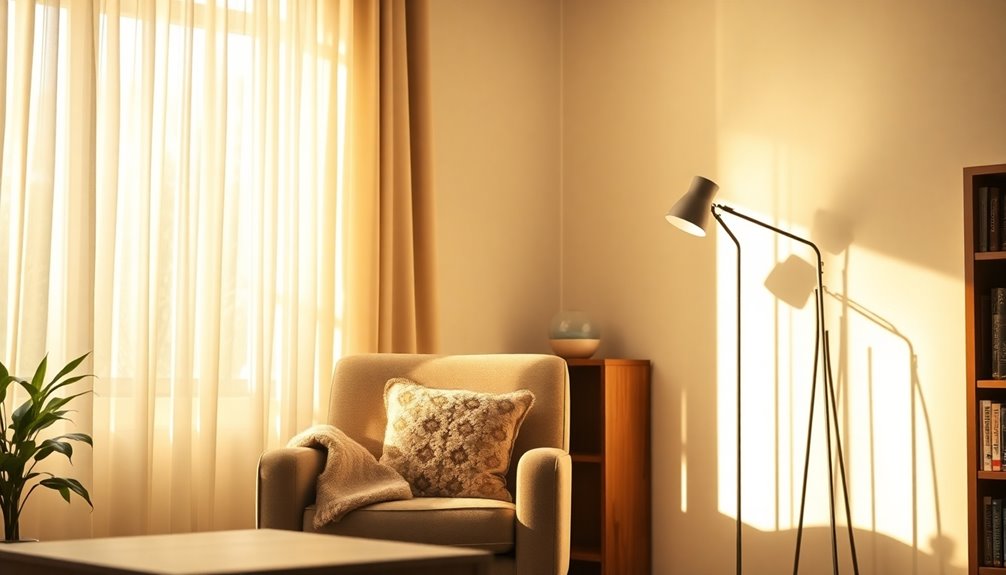
When you improve lighting in your home, you greatly enhance safety and comfort for seniors. Proper lighting boosts visibility, markedly reducing the risk of falls and accidents.
Consider installing night lights or motion sensors in hallways and stairwells to help seniors navigate safely during the night without the need for bright overhead lights. Touch lights on tables can make reading or hobbies easier for those with impaired vision.
Also, maximize natural light by cleaning windows and removing heavy curtains; this can elevate mood and improve sleep patterns. Additionally, ensuring good lighting can help in recognizing symptoms of ear pressure during colds, which may affect seniors' comfort and safety.
Finally, upgrade to energy-efficient LED bulbs. They provide better illumination while cutting electricity costs, making them a smart choice for seniors on fixed incomes.
Install Ramps & Handrails
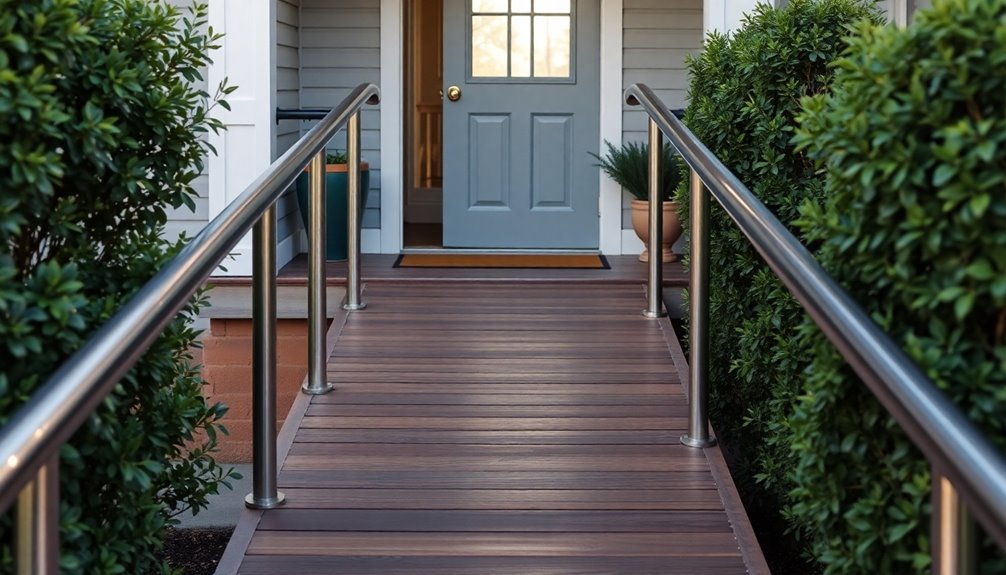
To enhance safety in your home, installing handrails and ramps is essential.
Handrails provide vital support on stairs, reducing the risk of falls, while ramps offer safe access for those with mobility challenges.
It's also important to follow safe installation guidelines and conduct regular maintenance checks to keep these features effective. Additionally, investing in a home security system can further ensure safety in your home, giving you peace of mind and protection against potential threats.
Importance of Handrail Support
Installing sturdy handrails on both sides of staircases is essential for ensuring senior safety and comfort. These handrails notably reduce the risk of falls, providing essential support for seniors as they navigate stairs.
To maximize safety and accessibility, consider the following:
- Handrails should extend the entire length of the staircase.
- Secure mounting is important for stability.
- Follow ADA guidelines: install handrails between 34 and 38 inches above the stair nosing.
- Regularly inspect handrails for wear and tear.
- Incorporate ramps alongside handrails to enhance mobility.
Safe Ramp Installation Guidelines
Safe ramp installation is essential for guaranteeing seniors can navigate their homes with ease and confidence.
Follow safe ramp installation guidelines to address mobility issues and create a secure living environment. Verify the ramp has a gentle slope of 1:12, using slip-resistant materials to prevent falls, especially when it's wet.
Sturdy handrails should be installed on both sides at a height between 34 and 38 inches for ideal support. The ramp must be at least 36 inches wide to comfortably accommodate mobility devices like wheelchairs and walkers.
Maintenance and Inspection Tips
While it's easy to overlook, regular maintenance and inspection of ramps and handrails are essential for guaranteeing the safety of seniors in their homes.
These checks help prevent slips and falls, providing peace of mind for you and your loved ones.
Here are some key tips to keep in mind:
- Inspect handrails for stability; verify they support at least 250 pounds.
- Verify that ramps have a slope ratio of 1:12 for safe navigation.
- Confirm handrails extend at least 12 inches beyond stairs for extra support.
- Maintain handrail height between 34 to 38 inches for ideal accessibility.
- Periodically clean ramps and check for wear, guaranteeing non-slip surfaces are intact.
Following these guidelines will enhance both safety and comfort in your home.
Update Flooring

Updating your flooring can make a big difference in safety at home.
Choose slip-resistant options like low-pile carpets or rubber-backed rugs, and make sure all carpets are securely attached to avoid tripping hazards.
Choose Slip-Resistant Options
Choosing slip-resistant flooring is essential for guaranteeing seniors can move around their homes without fear of falling. By selecting the right materials, you can greatly reduce the risk of slips and injuries.
Here are some key options to reflect on:
- Textured vinyl
- Rubber flooring
- Low-pile carpets
- ADA-approved anti-slip coatings
- Regular maintenance checks
These flooring materials meet ADA guidelines and help prevent slips while minimizing tripping hazards.
If you're using carpets, make sure they're securely attached and no thicker than half an inch. Regular inspections will also guarantee the safety features remain effective over time.
Secure Carpets and Rugs
To enhance safety in your home, securing carpets and rugs is an essential step. Loose carpets and rugs are significant tripping hazards for seniors living alone, increasing the risk of trips and falls. You can easily secure carpets and rugs using non-slip backing or double-sided tape to minimize movement. Additionally, consider replacing thick rugs with low-pile or rubber-backed alternatives to make your space safer for seniors.
Here's a quick reference to help you choose the right options:
| Action | Benefit |
|---|---|
| Use non-slip backing | Reduces movement |
| Replace thick rugs | Lowers tripping risk |
| Inspect regularly | Identifies potential hazards |
| Opt for slip-resistant flooring | Enhances overall safety |
These home improvements can make a significant difference in your living environment! Moreover, creating an organized environment can facilitate better decision-making by helping seniors easily navigate their spaces and identify potential hazards.
Shower and Bathtub Modification
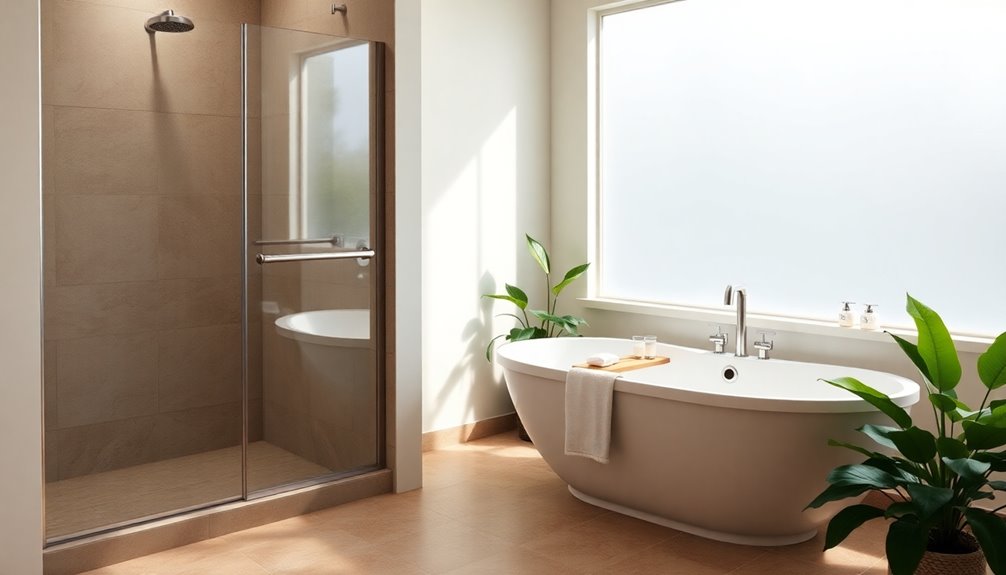
When considering modifications for your bathroom, enhancing safety and comfort in the shower and bathtub can make a significant difference in your daily routine.
Implementing these upgrades will support aging in place:
- Install grab bars in shower areas for added support.
- Replace standard tubs with a walk-in shower to reduce fall risks.
- Use a bathtub transfer bench to ease entry and exit.
- Consider a walk-in tub with built-in seating for convenience.
- Add non-slip safety strips to both bathtubs and shower floors.
These shower and bathtub modifications not only boost safety but also enhance your bathing experience, allowing you to feel more secure and comfortable in your home.
Prioritizing these elements can transform your daily routine.
Widen Doorways
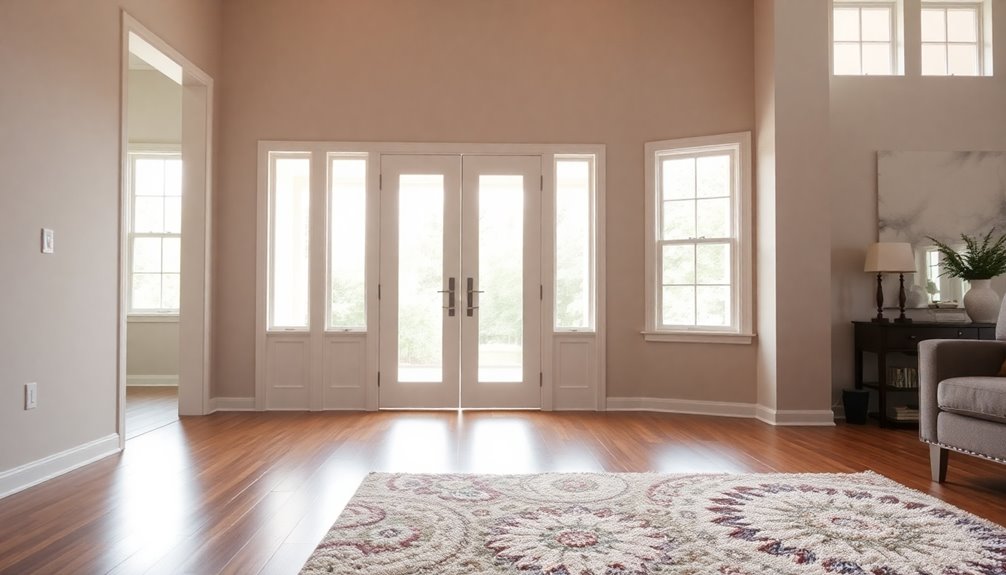
Widening doorways can greatly enhance mobility and access for seniors, making it easier to navigate their homes.
By expanding doorways to a minimum width of 32 inches, you guarantee that wheelchairs and walkers can pass through comfortably. This essential home modification not only promotes mobility for seniors but also aligns with Americans with Disabilities Act (ADA) guidelines, fostering a safer living environment.
Properly widened doorways considerably reduce the risk of accidents and falls, allowing for smoother shifts between rooms. Additionally, maintaining good indoor air quality is crucial for seniors' overall health and comfort, further enhancing their living experience.
While the cost of widening doorways can range from $500 to $3,000, the benefits of improved accessibility and convenience make it a worthwhile investment for enhancing daily life.
Replace Faucets
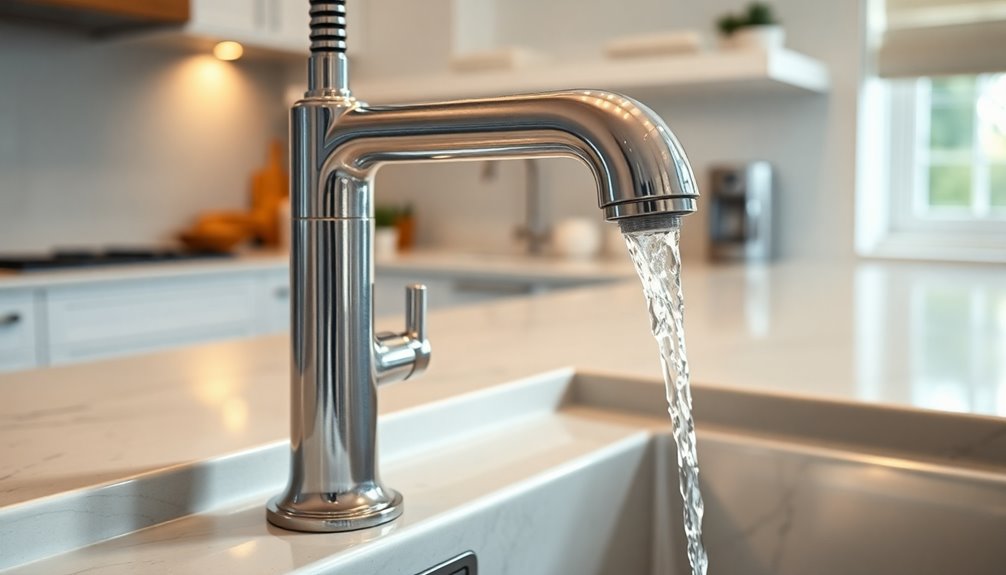
After making doorways more accessible, focusing on faucets can further improve safety and comfort in the home.
By replacing traditional twist faucet handles with lever-style handles, you'll make it easier for seniors with arthritis to operate them.
Consider these upgrades:
- Install touchless faucets to reduce physical contact.
- Choose anti-scald faucets to prevent burns from hot water.
- Lower your water heater temperature to 120 degrees Fahrenheit or less.
- Replace faucets to improve functionality and aesthetics.
- Create a more inviting environment that supports aging in place.
These changes not only make your home safer but also greatly enhance the quality of life for seniors. Incorporating features like grab bars, non-slip flooring, and improved lighting can significantly reduce the risk of falls and accidents. Additionally, creating an environment that fosters independence allows seniors to maintain their dignity and autonomy. Ultimately, these adjustments reveal the secrets to exceptional elderly care, ensuring that loved ones enjoy their golden years with comfort and security.
Prioritizing these upgrades guarantees a comfortable and secure living space for you and your loved ones.
Getting Financial Aid for Home Modification Projects
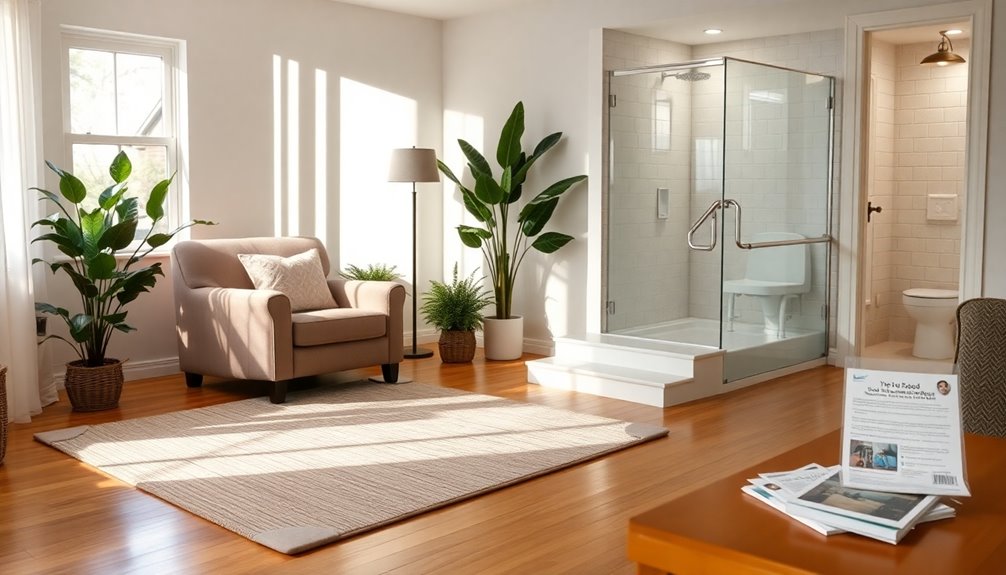
Securing financial aid for home modification projects can greatly ease the burden of creating a safer living environment for seniors. Many states offer financial assistance programs specifically tailored for home modifications, which you can find through resources like Paying For Senior Care.
Grants and loans are often available through non-profit organizations and government agencies, helping cover essential costs. If you're a veteran or a family member, additional support may be accessible through charities focused on assisting aging veterans.
Additionally, local governments frequently provide funding for home modifications as part of their aging in place initiatives, usually requiring proof of income or need. Utilizing these resources can considerably reduce the financial strain of making necessary home changes. Furthermore, understanding alimony types can be beneficial when navigating financial obligations after a divorce, which may impact your budget for home modifications.
Frequently Asked Questions
How Can You Make a Home Safe for the Elderly?
To make a home safe for the elderly, start by installing grab bars in bathrooms and stairways to prevent falls.
Switch to lever-style door handles for easier access and improve lighting with brighter bulbs and motion sensors.
Replace standard bathtubs with walk-in showers or add shower chairs for safer bathing.
Finally, guarantee everyday items are within easy reach to promote independence and reduce the risk of using step stools.
How to Modify a Home for the Elderly?
When it comes to modifying a home for the elderly, you've got to think ahead.
Start by installing grab bars and handrails in vital areas, like bathrooms and staircases, to prevent falls.
Upgrade to bright LED lighting to improve visibility, and swap out doorknobs for lever-style handles.
Don't forget to make bathrooms safer with walk-in tubs and secure storage for easy access to daily essentials.
These changes will help keep them safe and sound!
Who Does Home Safety Assessments for the Elderly?
When you're looking to improve home safety for elderly individuals, several professionals can help.
Occupational therapists specialize in evaluating home environments and can identify hazards. Local government agencies and non-profits often provide free or low-cost assessments.
Fire departments may also conduct safety checks focused on fire risks. Additionally, certified aging-in-place specialists (CAPS) can recommend modifications, and some insurance companies offer evaluations to help reduce risks and potentially lower premiums.
How to Prepare Your Home for Old Age?
To prepare your home for old age, start by evaluating potential hazards.
Install grab bars in bathrooms and handrails on staircases to prevent falls. Replace slippery flooring with non-slip options and remove loose rugs.
Enhance lighting with brighter bulbs and consider motion-sensor lights for visibility.
Widen doorways to accommodate mobility aids and think about incorporating smart home technology for added safety and convenience.
These changes can create a more secure living environment as you age.
Conclusion
By making these essential upgrades, you're not just enhancing safety; you're transforming your home into a haven of comfort and accessibility for seniors. Imagine a space where every corner radiates warmth, and every step feels like a gentle embrace. With improved lighting, ramps, and updated flooring, you'll create an environment that's as welcoming as a sunny afternoon. Don't wait for tomorrow—start these upgrades today and watch your home become a true sanctuary for your loved ones!
